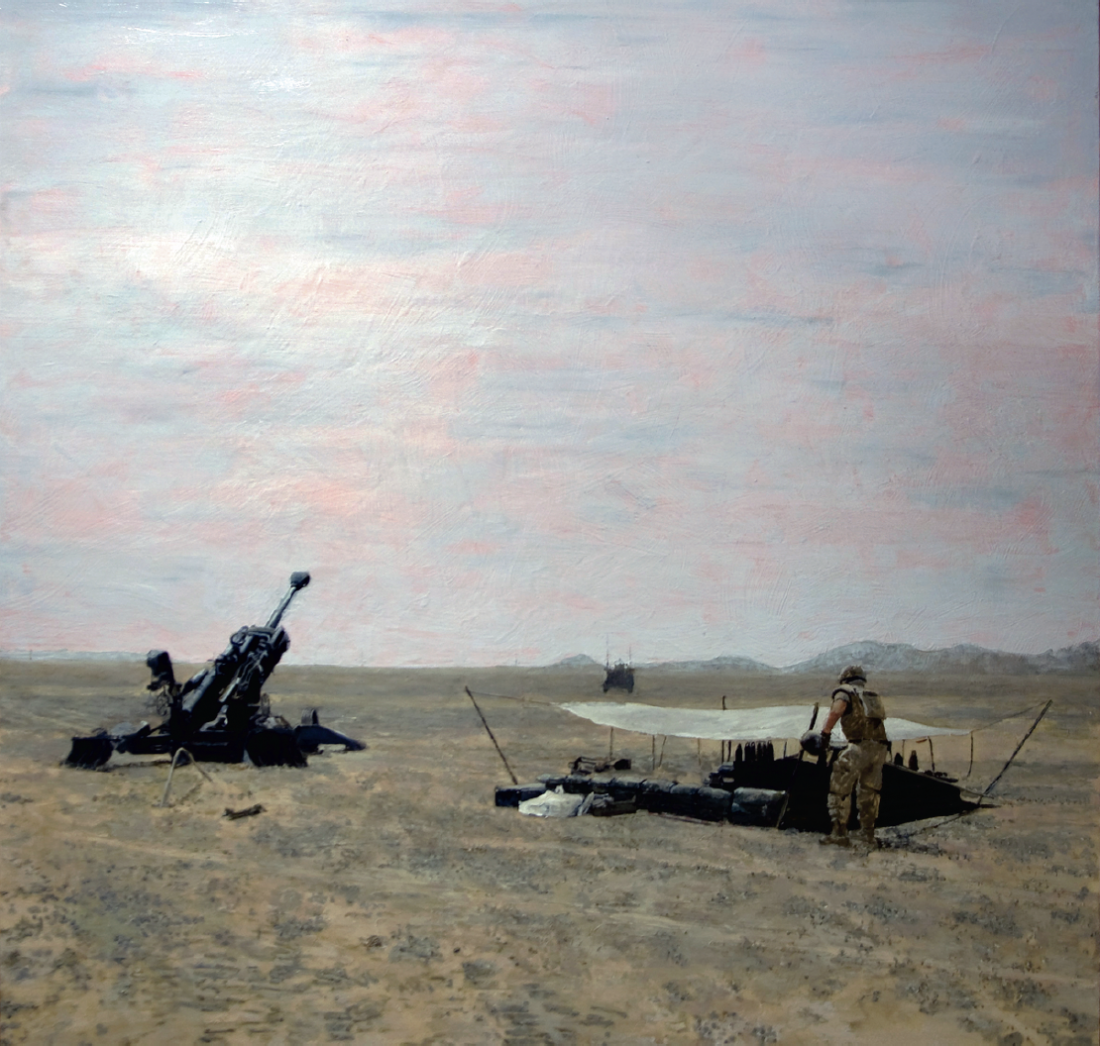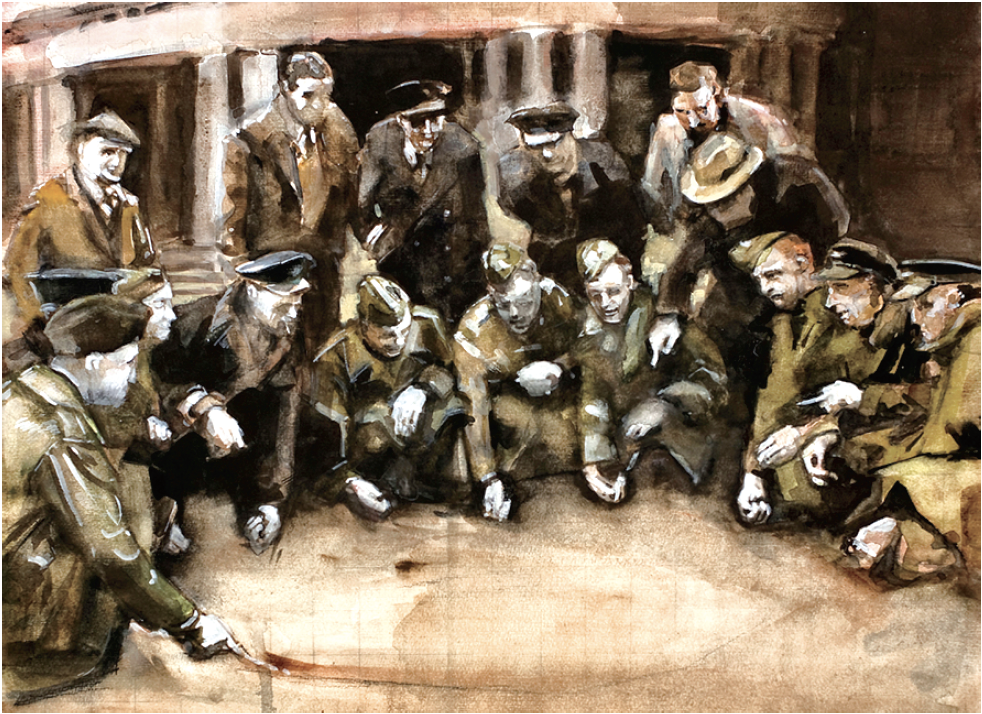“Reconnaissance” William MacDonnell and Todd Tremeer
To go on a reconnaissance mission in military terms is to gather information about the enemy. But it is a secondary meaning of reconnaissance— establishing the lay of the land through direct observation—that makes it an apt title for this exhibition. It is, after all, one that is decidedly about looking at and recording the sites of war. Neither Bill MacDonnell nor Todd Tremeer glorifies or condemns war in their work, each grappling with it from a place of quiet remove. Instead, both artists start from a common interest in history, asking understated questions about the role art plays in representing and memorializing conflict.
Brought together by circumstance more than careful curatorial foresight (limited space means artists are frequently paired, thematically whenever possible, in Modern Fuel’s modest main gallery space), MacDonnell and Tremeer in some ways tackle the issues from opposite ends of the negotiating table. It is, however, an effective pairing. MacDonnell, an established painter who recently relocated to Kingston after teaching at the Alberta College of Art and Design for more than a quarter-century, depicts bombed out buildings and the physical spaces and landscapes of war—in this case, places he has visited in Europe, Afghanistan and the Balkans—after conflict has moved. He makes luxurious paintings on large canvases with richly applied brushstrokes that move from painterly to more tightly representative, and back again.

William MacDonnell, Maiwand Battery, 2008, acrylic on canvas, 5’4” x 5’4”. Photograph: Geoff Chalcraft. Courtesy Modern Fuel Artist-Run Centre, Kingston, ON.
Tremeer, on the other hand, makes compelling smaller-scale watercolours of much more intimate battle scenes. His series of “Action Paintings” depict truncated combat scenes as staged within the confines of museum dioramas, while those in his “Replay” series are based on archival military photographs found through Google searches. The exhibit also includes a troop of paper-doll soldiers squatting in rows with their guns drawn (the exhibition’s only three-dimensional piece). Their work, when exhibited together, sets up a compelling dialogue. Where MacDonnell’s large landscapes are vast and unpopulated, they are based on real places and genuine destruction. Tremeer’s are smaller and more urgent, his loosely rendered conflict fed from within the imagination, though to no lesser effect.
MacDonnell’s contributions to “Reconnaissance” span two decades of his career. The most recent, like the barely dry Ruin Upon Ruin, 2010, was painted after MacDonnell spent time embedded with Canadian troops in Afghanistan as part of the war art program run by the Department of Defence. The large painting depicts the King’s Palace near Kabul, once occupied by the Soviets and now mostly destroyed by Taliban forces. The devastation gives the massive grey-brown structure, set here against a grey-blue sky, the look of an abandoned Roman ruin. The grey-slab buildings clustered before the palace in the painting’s middle ground are the scene’s second “ruin”—the remains of “Camp Julian,” the now unoccupied Canadian forces base that once housed more than 1000 soldiers, many of whom would have posed for photographs with the devastated palace in the background.
MacDonnell’s muted scene, however, is entirely void of human life, save for the traces left behind as senseless destruction. It’s impossible not to contemplate Canada’s presence in Afghanistan while gazing upon the abandoned spaces where Canadian troops once lived. Interestingly, MacDonnell devotes the painting’s foreground (almost half of the canvas) to the scrubby bushes and spiky grasses persevering in this bleak, empty landscape, as if nature might, in time, reclaim these defeated structures and start all over again.

Todd Tremeer, The Game, 2008, watercolour on paper, 50 x 65 cm. Photograph courtesy the artist. Courtesy Modern Fuel Artist-Run Centre, Kingston, ON.
In his accompanying essay about the exhibition, Modern Fuel’s Artis- tic Director Michael Davidge describes the signs of warfare in MacDonnell’s work as being like “visual echoes.” “Presenting sites of contemplation,” writes Davidge, “the paintings activate a kind of detective work or vigilance in the viewer, who searches for clues in their surfaces and their titles.” That’s certainly the case with MacDonnell’s impressive painting On the Wilhelmstrasse, Later in the Day, 1997, where a dark red brick building broken by war stands against a grey sky. Rubble crowds the building’s base, and its doors and windows yawn emptily. But this building isn’t merely another casualty: this one was Hitler’s Chancellery, the Nazi regime’s power centre in Berlin, a fact that decidedly alters the painting’s significance, but only to those who seek it out (though MacDonnell has made notes available to expand on the significance of each painting in the exhibition).
In some ways, Tremeer’s “Replay” series does the same thing: depicting moments whose significance is not always immediately accessible. Tremeer, who graduated in 2007 with an MFA from the University of Western Ontario (the same year he won the Joseph Plaskett award), finds his subjects for these paintings by performing Google searches for things like “soldiers with models.” The result is a fascinating collection of context-free paintings of soldiers doing everything except engaging in actual combat. In Painting, 2008, for example, a soldier concentrates on painting the wing of a model airplane, while in The Game, 2008, a group in uniform huddle together, their attention drawn to something (a game? a strategy session?) at their feet. Depicted in watercolour but in the original photograph’s muted hues, the scenes seem to aptly describe what feel like blurred memories, their edges smeary, their significance now displaced, or dislocated, from the original context.
Tremeer’s paintings of museum dioramas are equally intriguing. In Falaise Gap, 2007, tanks huddle too closely, packed into scruffy landscapes next to clusters of soldiers. The scene, too frenetic to feel accurate, is instead the work of a crafty model builder interpreting war in miniature for an unseen audience. In rendering that scene, Tremeer takes yet another step back, ceasing to ask questions about war but, instead, about its depiction and reconstruction in our collective memory. Ultimately, both Tremeer and MacDonnell are driven not by questions about war but by questions about history, asking us to consider not only how and what we choose to remember but, more fundamentally in these tumultuous times, who decides. ❚
William MacDonnell and Todd Tremeer’s “Reconnaissance” was exhibited at Modern Fuel Artist-Run Centre in Kingston, Ontario, from November 13 to December 18, 2010.
Meredith Dault is a freelance writer based in Halifax.

